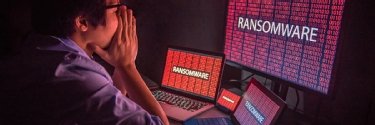News
-
 12 December 2025
12 December 2025
Streisand effect: Businesses that pay ransomware gangs are more likely to hit the headlines
-
 12 December 2025
12 December 2025
Trump plans bonfire of US state-level AI regulation
-
 12 December 2025
12 December 2025
National Audit Office praises Bank of England after complex mega-project
-
 12 December 2025
12 December 2025
US nears universal adoption as North America leads 5G
News Archive
-
December 12, 2025
12
Dec'25
Streisand effect: Businesses that pay ransomware gangs are more likely to hit the headlines
Research by ransomware expert Max Smeets suggests companies that pay up to criminal gangs are more likely to attract press attention
-
December 12, 2025
12
Dec'25
Trump plans bonfire of US state-level AI regulation
US president’s executive order targets state-level AI regulatory frameworks across the country, saying they are too onerous and endangering leadership in the field
-
December 12, 2025
12
Dec'25
National Audit Office praises Bank of England after complex mega-project
Public spending watchdog says the Bank of England’s core system replacement project offers lessons to other government departments
-
December 12, 2025
12
Dec'25
US nears universal adoption as North America leads 5G
Study finds over 99% 5G penetration in US, almost three times more than global average, with global 5G connections reaching 2.8 billion and global cellular IoT subscriptions surpassing four billion
-
December 12, 2025
12
Dec'25
ESA promises smarter flights for ITA Airways through sat comms
Italian airline deploys comms system designed to enable digital, real-time connectivity and offload current ground systems for air traffic management, showing how satellites can complement terrestrial infrastructure
-
December 12, 2025
12
Dec'25
University of York plumps for Workday to spruce up HR and finance
The University of York is replacing 57 HR and finance systems with a Workday platform, supported by KPMG, aiming for real-time insights and simpler processes
-
December 12, 2025
12
Dec'25
Interview: Erik Mayer, transformation chief clinical information officer, Imperial College
With both a clinical and a digital background, the healthcare tech leader is using data to improve collaboration across an NHS trust for the benefit of medical staff and patients
-
December 12, 2025
12
Dec'25
Three in five businesses more confident in Wi-Fi investment
Research finds 60% of businesses see converged Wi-Fi and 5G as key to enterprise flexibility, with 38% planning to roll out Wi-Fi 7 in 2025/2026, while 65% say 6 GHz availability is important to their Wi-Fi business
-
December 12, 2025
12
Dec'25
Consumers trade up smartphones for AI
Quarterly study of US mobile trade-in arena finds 46% growth year-on-year driven by accelerated adoption of AI-enabled devices and expansion of the secondary market, with the third consecutive record-breaking quarter for revenues
-
December 12, 2025
12
Dec'25
Digital Ethics Summit 2025: Open sourcing and assuring AI
Industry experts met to discuss the ethical challenges associated with assuring AI systems, and how open source approaches can challenge concentrations of capital and power
-
December 11, 2025
11
Dec'25
Interview: Art Hu, global CIO, Lenovo
The IT chief at the PC, servers and storage supplier is using his experience of rolling out tech internally to boost the growing services ambitions of the Chinese tech giant
-
December 11, 2025
11
Dec'25
Harrow Council votes on Cellnex to advance borough connectivity
North London council announces a partnership with telecoms infrastructure operator to deploy small cell technology and target connectivity blackspots around high streets and transport hubs
-
December 11, 2025
11
Dec'25
Oracle expects to increase OCI margins by 30-40%
Market analysts are concerned about the AI bubble bursting, but Oracle’s latest earnings call shows it is still expanding datacentre roll-outs
-
December 11, 2025
11
Dec'25
Microsoft expands bug bounty scheme to include third-party software
The company is to offer bug bounty awards for people who report security vulnerabilities in third-party and open source software impacting Microsoft services
-
December 11, 2025
11
Dec'25
Qatar launches Qai to accelerate national and regional AI ambitions
State-backed company Qai aims to build secure AI infrastructure and position Qatar as a leading Gulf innovation hub
-
December 11, 2025
11
Dec'25
UAE’s e& enterprise brings Amdocs and Nvidia AI into live telco operations
The Emirati operator moves beyond pilots, using AI agents to streamline customer care and network operations
-
December 10, 2025
10
Dec'25
Google DeepMind partners with UK government to deliver AI
The partnership promises to provide scientists with access to advanced AI models, as well as help the government become more streamlined
-
December 10, 2025
10
Dec'25
How digital twins are helping people with motor neurone disease speak
Tech companies, a charity and academics have collaborated to create AI-powered avatars that are helping people with motor neurone disease hold natural conversations
-
December 10, 2025
10
Dec'25
IT spending bonanza biggest in 30 years
Artificial intelligence is driving purchases of IT products and services at a level not seen since the web went mainstream
-
December 10, 2025
10
Dec'25
UK government funds 80 digital skills schemes
The £11.7m Digital Inclusion Innovation Fund will support projects across the UK to help people gain digital skills and access to devices
-
December 10, 2025
10
Dec'25
Error-prone eVisa system a precursor of digital ID
Research highlights how the Home Office’s electronic visa system has used migrants as a ‘testing ground’ for the government’s wider digital ID ambitions
-
December 09, 2025
09
Dec'25
Microsoft patched over 1,100 CVEs in 2025
The final Patch Tuesday update of the year brings 56 new CVEs, bringing the year-end total to more than 1,100
-
December 09, 2025
09
Dec'25
Interview: Meet the competition lawyer taking Microsoft to task over its cloud licensing tactics
Microsoft’s approach to cloud licensing has been labelled anti-competitive and cost-prohibitive to enterprises by regulators, and now Maria Luisa Stasi is the competition lawyer looking to take the company to task over its behaviour
-
December 09, 2025
09
Dec'25
Airline set to launch with end-to-end AI workflows
IBM has been working with Riyadh Air to develop a digital-first, AI native airline that uses its Watson technology on OpenShift running on Azure
-
December 09, 2025
09
Dec'25
How Chinese-owned Radisson Hotel Group split US enterprise resource planning
During the UK and Ireland SAP user group conference in Birmingham, Computer Weekly met with the SAP platform lead at Radisson Hotel Group
-
December 09, 2025
09
Dec'25
MPs maul digital ID plans in Parliamentary debate
MPs brand the government’s digital ID plans ‘un-British’ and ‘an attack on civil liberties’ during debate on the controversial policy
-
December 09, 2025
09
Dec'25
How Oracle Red Bull Racing is driving Formula 1 into the future with cloud, AI and data
Access to the F1 team’s garage in Abu Dhabi reveals how Monte Carlo simulations, artificial intelligence and Oracle Cloud Infrastructure power split-second decisions, strategy and championship-winning performance
-
December 09, 2025
09
Dec'25
Cloudera CEO on the Middle East’s hybrid AI future: ‘Workload portability is the foundation’
Charles Sansbury explains how Gulf enterprises are driving demand for private AI, data sovereignty and hybrid architectures as hyperscalers compete for their workloads
-
December 09, 2025
09
Dec'25
Why bug bounty schemes have not led to secure software
Computer Weekly speaks to Katie Moussouris, security entrepreneur and bug bounty pioneer, about the life of security researchers, bug bounties and the artificial intelligence revolution
-
December 09, 2025
09
Dec'25
Fujitsu underestimated Post Office scandal backlash
Troubled IT supplier loses UK government megadeal despite internal confidence, as political pressure mounts
-
December 09, 2025
09
Dec'25
Alcatel-Lucent, Nokia team to deliver end-to-end enterprise network services
Enterprise secure networking services provider and global comms tech firm expand partnership to provide joint networking, driving digital transformation at deployment sites
-
December 09, 2025
09
Dec'25
Tricentis looks to agentic AI as firms risk losses from untested code
With 42% growth in the Asia-Pacific region, the software testing firm is pushing autonomous AI agents to help enterprises balance the pressure for speed against the high cost of software failures
-
December 09, 2025
09
Dec'25
OAIC to launch blitz on privacy compliance
Australia’s privacy watchdog will begin the new year with a compliance sweep targeting businesses that run afoul of privacy rules, including the over-collection of personal information in-person, warning that non-compliance could trigger fines
-
December 08, 2025
08
Dec'25
NCSC warns of confusion over true nature of AI prompt injection
Malicious prompt injections to manipulate GenAI large language models are being wrongly compared to classical SQL injection attacks. In reality, prompt injection may be a far worse problem, says the UK’s NCSC
-
December 08, 2025
08
Dec'25
How police live facial recognition subtly reconfigures suspicion
A growing body of research suggests that the use of live facial recognition is reshaping police perceptions of suspicion in ways that undermine supposed human-in-the-loop protections
-
December 08, 2025
08
Dec'25
UK altnet market ‘entering its most dangerous phase yet’
Research predicts shakeout for UK’s independent broadband sector, with likely survivors being those companies that build infrastructure where it matters, invest where returns can be realised and collaborate where value can be unlocked
-
December 08, 2025
08
Dec'25
SBB undertakes Europe’s first major railway with IMS, VoLTE comms
Infrastructure upgrade offers onboard 4G service designed to ensure nationwide comms for rail network ahead of planned decommissioning of 3G, redefining connectivity and reliability
-
December 08, 2025
08
Dec'25
Number of UK social care providers using digital records hits 80%
Use of digital records in social care has doubled, as the UK government explores options to link digital care records with the NHS
-
December 08, 2025
08
Dec'25
Amazon CTO on the dawn of the renaissance developer
While AI is commoditising programming, it is creating a demand for modern polymath engineers who understand systems, business context and the human condition, says Amazon CTO Werner Vogels
-
December 05, 2025
05
Dec'25
Cyber teams on alert as React2Shell exploitation spreads
Exploitation of an RCE flaw in a widely used open source library is spreading quickly, with China-backed threat actors in the driving seat
-
December 05, 2025
05
Dec'25
Interview: Paul Neville, director of digital, data and technology, The Pensions Regulator
Data, automation and artificial intelligence are driving the regulator to take new approaches to its work and how it supports the pensions industry, leading to improved experiences for everyone in the UK who has a pension
-
December 05, 2025
05
Dec'25
Edinburgh Airport grounds flights due to IT issue affecting air traffic control provider
An unspecified IT issue affecting Edinburgh Airport’s air traffic control services provider has led to flight delays and cancellations
-
December 05, 2025
05
Dec'25
Cloudflare fixes second outage in a month
A change to web application firewall policies at Cloudflare caused problems across the internet less than three weeks after another major outage at the service, but no cyber attack is suspected
-
December 05, 2025
05
Dec'25
Jersey to get remote monitoring for vulnerable adults
Jersey’s Family Nursing and Home Care (FNHC) hopes remote monitoring service will help keep people out of hospital and support care at home
-
December 04, 2025
04
Dec'25
NCC supporting London councils gripped by cyber attacks
Three west London councils hit by a cyber attack continue to investigate as services remain disrupted nearly two weeks on
-
December 04, 2025
04
Dec'25
Constrained budgets left security teams short-handed in 2025
With 2024 seeing surges in security funding cuts, lay-offs and hiring freezes, 2025 brought some relief for cyber pros, but constrained budgets are leaving security teams short-staffed
-
December 04, 2025
04
Dec'25
Home Office launches police facial recognition consultation
The Home Office has formally opened a 10-week consultation on a legal framework for police use of facial recognition technologies, and will consider extending any new rules to police deployments of other biometric and inferential technologies
-
December 04, 2025
04
Dec'25
UK Space Agency pumps £17m into tech projects
The agency is funding 17 different projects through its National Space Innovation Programme, including the design of an AI-powered satellite radar
-
December 04, 2025
04
Dec'25
Western coalition supplying tech to Ukraine prepared for long war
Russia is deploying hybrid warfare against Europe as western nations supply critical IT and telecoms equipment to Ukraine’s front line
-
December 04, 2025
04
Dec'25
Fujitsu police contract ‘complicates’ Post Office investigation
National Police investigation into Post Office scandal uses IT infrastructure provided by Fujitsu


